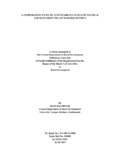Please use this identifier to cite or link to this item:
https://elibrary.tucl.edu.np/handle/123456789/2230| Title: | A Comparative Study of Acountability Status of Naumuleand Rawatkot Vdcs of Dailekh District |
| Authors: | Regmi, Hast Raj |
| Issue Date: | 2017 |
| Publisher: | Central Department of Rural Development |
| Abstract: | This dissertation is based on two VDCs- Naumule and Rawatkot of Dailekh district, a hilly and mountainous district. The research was carried out for two months in October and November 2016 for a comparative study in Naumule VDC which is adjacent to district headquarters Dailekh and in Rawatkot VDC, which is at around 35 km distance from the district headquarters. The main objectives of the study were to assess the level of people's participation in VDCs programs, to trace out transparency situation of the VDCs and to explore accountability status of VDCs. These three elements – participation, transparency and accountability are the components of good governance, among its various other components. Therefore, in a way, the study also targeted to find out and compare the situation of good governance in two VDCs. People's participation in developmental activities is one of the most important factors for this study. Need identification, benefit sharing and monitoring and evaluation, these 3 stages would help find out the whole participation level. In the need identification stage, 34 people of Naumule and 105 people of Rawatkot's respondents participated. In Naumule VDC, Janajati had the highest (24) participation in Naumule whereas Dalit participation was the highest (45) in Rawatkot. Gender-wise, male participation dominated the female participation. In both the VDCs, Dalits and male respondents' participation is higher. But comparatively, the situation in Naumule VDC was worse as compared to Rawatkot in terms of need identification stage. The participation of Dalits in VDC activities in need identification, benefit sharing, monitoring and evaluation stages was found to be higher than Janjatis and Dalits. From gender perspectives, male participation has been found higher than female participation. Participation in Naumule VDC, which is adjacent to district headquarters, is higher than in Rawatkot VDC, which is at around 35 km away from the district headquarters. Very negligible amount of monitoring and evaluation works have been done so far. In terms of transparency, there is no practice of maintaining Information Board, and information dissemination mechanism and no trend of making the budget public. As for accountability, due to the absence of elected body, the VDC officials are not taking that much responsibility for being accountable to the people. People have to struggle to meet them and they are not easily accessible as they do not stay in the VDC and are mostly based in the district headquarters. As a consequence, people have not been able to have an easy access to the services. In brief, it will be very tough and daunting task for the local bodies to ensure participation, transparency and accountability, i.e. good governance in totality, if the local bodies' election is not held at the earliest and gets deferred all the time as it is today. The benefit sharing stage also shows the hierarchy of Dalits groups and male respondents at the upper level. A total of 60 percent of Dalits group's respondents said they were equally benefited as others. But only 36 percent of Janjati and 43 percent of others respondents agreed with this. vi |
| URI: | http://elibrary.tucl.edu.np/handle/123456789/2230 |
| Appears in Collections: | Rural Development |
Files in This Item:
| File | Description | Size | Format | |
|---|---|---|---|---|
| thesis dailekh final.pdf | 547.25 kB | Adobe PDF |  View/Open |
Items in DSpace are protected by copyright, with all rights reserved, unless otherwise indicated.
